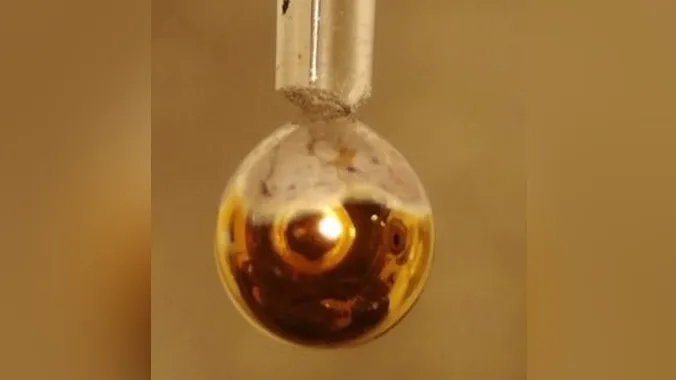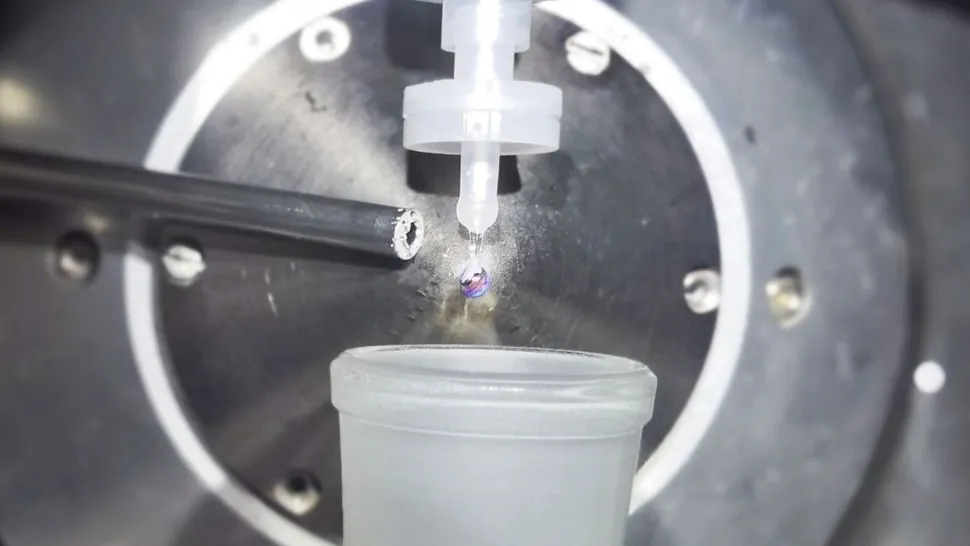과학자들은 물을
빛나는 황금
금속으로 바꾼다.
By Nicoletta Lanese - Staff Writer 16 days ago
16일 전 직원 작가 -
Nicoletta Lanese

(Image credit: HZB)
(사진제공: HZB)
In a mind-bending experiment, scientists transformed purified water into metal for a few fleeting seconds, thus allowing the liquid to conduct electricity.
정신을 굴절시키는 실험에서,
과학자들은
액체가 전기를
전도할 수 있게끔함으로
정제수를 몇 초 동안
금속으로 변화시켰다.
Unfiltered water can already conduct electricity — meaning negatively charged electrons can easily flow between its molecules — because unfiltered water contains salts, according to a statement about the new study. However, purified water contains only water molecules, whose outermost electrons remain bound to their designated atoms, and thus, they can't flow freely through the water.
새로운 연구에 대한
발표에 따르면,
여과되지 않은 물은
염분을 포함하고 있기 때문에 —
음전하를 띤 전자가
분자 사이에서
쉽게 흐를 수 있음을 의미하는 —
여과되지 않은 물은
이미 전기를 전도할 수 있다.
그러나, 정수된 물은
물 분자만 포함하고 있어
최외곽 전자가
지정된 원자에 묶여 있어
물 속을 자유롭게
흐르지 못한다.
Theoretically, if one applied enough pressure to pure water, the water molecules would squish together and their valence shells, the outermost ring of electrons surrounding each atom, would overlap. This would allow the electrons to flow freely between each molecule and would technically turn the water into a metal.
이론적으로
순수한 물에
충분한 압력을 가하면
물 분자가 뭉쳐서
각 전자를 둘러싸고 있는
원자의 가장 바깥 고리인
원자가 껍질이
겹쳐지게 된다.
이것은
각 분자 사이에
전자가 자유롭게 흐르게 하고
기술적으로 물을 금속으로
변화시킬 것이다.
Related: The surprisingly strange physics of water
관련항목: 놀랍도록 이상한
물의 물리학
The problem is that, to squash water into this metallic state, one would need 15 million atmospheres of pressure (about 220 million psi), study author Pavel Jungwirth, a physical chemist at the Czech Academy of Sciences in Prague, told Nature News & Comment. For this reason, geophysicists suspect that such water-turned-metal might exist in the cores of huge planets like Jupiter, Neptune and Uranus, according to Nature News.
프라하에 있는
체코 과학 아카데미의 물리 화학자인
연구논문 저자 파벨 융워스는
네이처 뉴스 & 코멘트와의 인터뷰에서
"문제는 이 금속 상태로
물을 찌그러뜨리기 위해서는
1,500만 기압(약 2억 2,000만
psi: 평방 인치당 파운드)의
압력이 필요하다는 것"이라고 말했다.
이 때문에
지구물리학자들은
목성, 해왕성, 천왕성 같은
거대한 행성들의 중심부에
이러한 물처럼 변하는 금속이
존재할 것으로 추측하고 있다고
네이처 뉴스는 전했다.
But Jungwirth and his colleagues wondered whether they could turn water into metal through different means, without creating the ridiculous pressures found in Jupiter's core. They decided to use alkali metals, which include elements like sodium and potassium and hold only one electron in their valence shells. Alkali metals tend to "donate" this electron to other atoms when forming chemical bonds, because the "loss" of that lone electron makes the alkali metal more stable.
그러나 융워스와 그의 동료들은
목성의 중심부에서 발견되는
터무니없는 압력을 만들지 않고
다른 방법으로
물을 금속으로 바꿀 수 있을지
궁금해했다.
그들은 나트륨과 칼륨과 같은
원소를 포함하고
원자가 껍질에
단 하나의 전자만을 포함하는
알칼리 금속을 사용하기로
결정했다.
알칼리 금속은
화학 결합을 형성할 때
이 전자를 다른 원자에
"기증"하는 경향이 있는데,
그 이유는
단 하나의 전자의 "손실"이
알칼리 금속을 더 안정적으로
만들기 때문이다.
Alkali metals can explode when exposed to water, and Jungwirth and his colleagues have actually studied these dramatic reactions in the past, according to Cosmos Magazine. But they theorized that, if they could somehow avoid the explosion, they could borrow electrons from alkali metals and use those electrons to turn water metallic.
코스모스 매거진에 따르면
알칼리 금속은 물에 노출되면
폭발할 수 있으며,
융워스와 그의 동료들은
과거에 실제로 이러한
극적인 반응을 연구해 왔다고
한다.
하지만 그들은
어떻게든 폭발을 피할 수 있다면
알칼리 금속에서 전자를 빌려
이들전자들을 물 금속으로 바꾸는데
사용할 수 있다고 이론화했다.

In a new experiment, scientists exposed droplets of metal to water vapor in a vacuum chamber, and this transformed the water into metal for a few seconds. (Image credit: HZB)
새로운 실험에서
과학자들은
진공실에서
금속 방울을
수증기에
노출시켰고,
이것이
물을
몇 초 동안
금속으로
변화시켰다.
(사진제공: HZB)
In their new experiment, described in a report published Wednesday (July 28) in the journal Nature, the team did just that. In the experiment, they placed a syringe filled with sodium and potassium in a vacuum chamber, squeezed out small droplets of the metals, which are liquid at room-temperature, and then exposed said metal droplets to a tiny amount of water vapor. The water formed a 0.000003 inch (0.1 micrometer) film over the surface of the metal droplets, and immediately, electrons from the metals began rushing into the water.
그팀은
수요일 (7월 28일)
학술지 네이처에 게재된
보고서에서
이렇게 설명했다.
실험에서는
나트륨과 칼륨을
가득 채운 주사기를
진공실에 넣고
실온에서
액체인 금속의
작은 방울을 짜낸 뒤
그 금속 방울을
소량의 수증기에
노출시켰다.
물은
금속 방울 표면에
0.000003인치(0.1마이크로미터)의
막을 형성했고
곧바로 금속에서 나온 전자가
물 속으로 밀려들기 시작했다.
For the experiment to work, the electrons had to move faster than an explosive reaction could take place, Jungwirth told Nature News. And once the electrons zoomed from the alkali metals to the water, an incredible thing happened: For a few short moments, the water turned a shiny, golden yellow color. Using spectroscopy, the team was able to show that the bright yellow water was in fact metallic.
융워스는
이 실험이
성공하기 위해서는
전자가
폭발 반응이 일어날 수 있는
속도보다
더 빨리 움직여야 했다고
네이처 뉴스에 전했다.
그리고 전자가
알칼리 금속에서
물로 확대되자,
다음과 같은 놀라운 일이
일어났다:
잠시 동안 물은
반짝이는 황금빛
노란색으로 변했다.
연구팀은
분광학을 이용해
밝은 노란색 물이
사실 금속성이라는 것을
증명할 수 있었다.
"Our study not only shows that metallic water can indeed be produced on Earth, but also characterizes the spectroscopic properties associated with its beautiful golden metallic luster," study author Robert Seidel, head of the Young Investigator Group at Humboldt University of Berlin, said in the statement. "You can see the phase transition to metallic water with the naked eye," he added.
베를린 훔볼트 대학의
젊은 조사단장인
로버트 세이델은
성명에서
"우리의 연구는
지구에서 금속수가
실제로
생성될 수 있다는 것을
보여줄 뿐만 아니라
아름다운 금빛 금속 광택과
관련된 분광학적 특성도
보여준다"고 말했다.
그는 "육안으로
금속수로의 위상 전환을
볼 수 있다"고 덧붙였다.
"It was amazing, like [when] you discover a new element," Jungwirth told Nature News & Comment.
정워스는
네이처 뉴스 & 코멘트와의
인터뷰에서
"새로운 요소를
발견했을 때처럼
놀라웠다"고 말했다.
Originally published on Live Science.
라이브 사이언스에 원본으로 발간됨.

댓글 없음:
댓글 쓰기